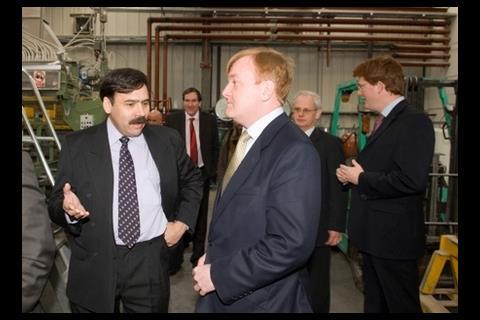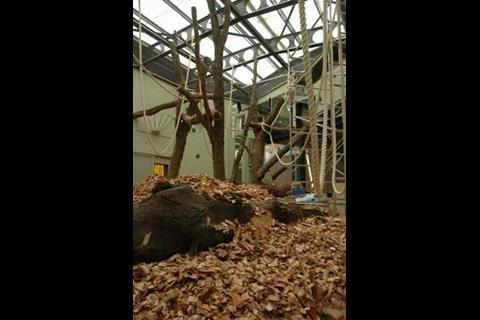Manufacturing firm Hambleside Danelaw has taken the bull by the horns and embraced a sustainable agenda in every part of its business offering. The results, in terms of its carbon footprint and the strides the firm has taken to reduce waste and to develop rethink their whole approach to designing and manufacturing products, are impressive
- Products designed to extend their lifecycle
- Waste materials sent to landfill reduced from 900 tonnes per annum to 3 tonnes in eight years
- First company in its sector to accept responsibility for recycling products at the end of their service life
- Carbon emissions halved in five years; 110% of carbon emissions offset; all power bought from renewable resources
- New products developed using recycled materials
Hambleside Danelaw has a glossy company brochure entitled ‘Our changing environment’. The cover features evocative images of a vivid green leaf, crashing waves, dramatic weather and a dry cracked lake bed. Inside, the brochure tells of the company’s commitment to a sustainable future and shows bar charts with dramatically falling amounts of waste and emissions. This is all well and good but what is the company actually doing? How is it making a difference?
“We are carbon neutral, plus ten percent,” says quality, safety and environment manager Ray Khan. “We have taken steps to account for every action and impact that Hambleside Danelaw does or has, from raw material extraction and transportation, through the production and packaging processes to in-life product maintenance and end-of-life recycling.”
In 2001 the company, which makes roofing products, embarked on what would become an all-embracing environmental strategy. It now recycles all paper, steel, plastics and cardboard offsite, while GRP from the production of roof lights is reprocessed on site and integrated into wall board manufacture. The result is a drastic reduction in the amount of material sent to landfill, from 900 tonnes per annum in 2001 to a target three tonnes in 2008.
Sale and return
The company also offers a return/recycling service for its products at the end of their service life. “The building owner or demolition company simply contacts us and we arrange for the product to be returned to our premises, where we strip it down and recycle and reuse the materials,” says Khan. “Add to this the fact that we’ve engineered our In Plane 45 roof lights to last almost twice as long as most on the market and we’ve halved the carbon emissions created in manufacture.”Hambleside Danelaw’s work so far has seen it reduce its greenhouse gas emissions from 1,308 tonnes per annum in 2005 (independently audited by the Edinburgh Centre for Carbon Management) to 900 tonnes in 2007: it is targeting a 46% reduction, to 725 tonnes by 2010. At current offset prices of £5-£10 per carbon tonne the company only has to spend around £9,000 to offset its total carbon emissions in 2007. However, the manufacturing processes used at Hambleside Danelaw will always create carbon emissions and elements such as the company’s supply chain and transport add to its carbon footprint.

Offsetting
“We have taken steps to offset our emissions, plus an extra 10%,” says Khan. “While offset schemes may not be the ultimate answer, with careful planning you can make a difference.” Khan believes that those wishing to offset should be careful to choose the best carbon credit schemes: “Check how they are derived and ensure that they can be independently verified. Also look into the length of the lifetime of the offset: tree planting has a finite life, while clean energy production projects make an instant impact.” Hambleside Danelaw offsets its emissions by contributing to a hydro-electric project in Guatemala and a scheme that installs solar panels and computers to schools in South Africa.Another positive impact that the company makes is closer to home. In converting all of its energy purchasing at the Inverness plant to renewable resources, it buys approximately one third of the power generated by a community wind turbine on the Isle of Gigha in the Hebrides. Money spent by Hambleside Danelaw is ploughed straight back into the island community.
Future work
Khan is already on the case when it comes to reducing carbon emissions further, towards the 725 tonnes target for 2010. “We are working with our suppliers now to see what they can do and we’re also looking into how we can reduce our transport requirements, both for materials and employees: that means reducing minimising product miles, hybrid company vehicles and encouraging car sharing and cycling.“Our staff and many of the people we deal with see the need to take action to reduce our impact on the environment but others need to get tuned into the fact that we can’t go on as we are.”
Khan understands the consequences of global warming and the need to reduce our carbon footprint but he can’t understand why even the sceptics don’t see the sound business reasons for implementing measures such as those at Hambleside Danelaw. “If you reduce the amount of energy you use you save money; if you cut down on waste you save money; and, as a direct consequence you reduce emissions. Even if you don’t care about the planet do what we do, boost the profile of your company and make money at the same time.”





























